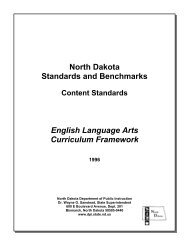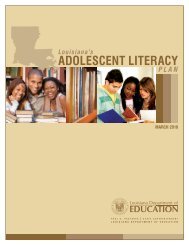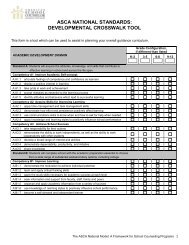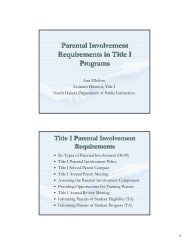Fifteen Effective Strategies for Improving Student Attendance
Fifteen Effective Strategies for Improving Student Attendance
Fifteen Effective Strategies for Improving Student Attendance
Create successful ePaper yourself
Turn your PDF publications into a flip-book with our unique Google optimized e-Paper software.
programs feature small class sizes, individualized and interdisciplinary<br />
instruction, learning styles based classroom settings, and various<br />
methods of academic and behavioral intervention. Contact: Gary<br />
Braun, Principal; Southtowns Academy; 4540 Southwestern Blvd.;<br />
Hamburg, NY 14075; telephone: 716-312-0940; fax: 716-312-0947;<br />
email: gbraun@erie1.wnyric.org<br />
Web Sites<br />
• National Center <strong>for</strong> Accelerated Schools PLUS has extensive experience<br />
in schools serving at-risk kids, and experience in targeting<br />
student strengths and providing know-how about strategies<br />
<strong>for</strong> high-end learning. http://www.acceleratedschools.net/<br />
• TAS Online. The Accelerated School is a national model of private/<br />
public partnerships that comprehensively serves the education<br />
and wellness needs of its students. http://www.accelerated.org/<br />
H/Enter.htm<br />
Career and Technical Education (CTE)<br />
General Definition<br />
A quality CTE program and a related guidance program are essential<br />
<strong>for</strong> all students. School-to-work programs recognize that youth<br />
need specific skills to prepare them to measure up to the increased<br />
demands of today’s workplace.<br />
“A truant child is likely to be ill prepared <strong>for</strong> skilled work—an<br />
increasingly serious problem given the shrinking demand <strong>for</strong> unskilled<br />
labor in the United States” (Heilbrunn & Seeley, 2003, p. 3).<br />
High-risk students enrolled in career academies were absent less<br />
frequently than their non-academy peers (Stone, 2004).<br />
Publications<br />
Heilbrunn, J. A., & Seeley, K. (2003). Saving money saving youth: The<br />
financial impact of keeping kids in school (3 rd ed). Retrieved March<br />
3, 2005, from http://www.truancyprevention.org/documents/<br />
Donner-FINALREPORT2003_003.pdf<br />
Kemple, J. J., & Snipes, J. C. (2000). Career academies: Impacts on<br />
students’ engagement and per<strong>for</strong>mance in high school. NY: Manpower<br />
Demonstration Research Corp.<br />
Plank, S. (2001). Career and technical education in the balance: An<br />
analysis of high school persistence, academic achievement, and<br />
postsecondary destinations. Saint Paul, MN: National Research<br />
Center <strong>for</strong> Career and Technical Education.<br />
Reese, S. (2005, March). The role of career and technical education<br />
in dropout prevention. Techniques, 30(3), p. 18-23.<br />
Stone, J. R. III. (2004). Career and technical education: Increasing<br />
school engagement. In J. Smink & F. P. Schargel (Eds.), Helping<br />
students graduate: A strategic approach to dropout prevention (pp.<br />
177-184). Larchmont, NY: Eye on Education.<br />
20<br />
Model Programs<br />
The Sinclair Community College Fast Forward Center of Montgomery<br />
County, Ohio, started in April 2001. Through the Center,<br />
1,600 young people are in a variety of career-based educational<br />
environments. The curriculum has three main components: basic<br />
skills instruction through computer-based learning, technical training<br />
to teach job ready skills, and life skills to help students cope.<br />
They have established eight new alternative programs, one of which<br />
is Young Mothers/Fathers. The Center works in partnership with the<br />
Juvenile Court and Montgomery County School Districts. Contact:<br />
James Brown, Director; Sinclair Community College; 1133 South<br />
Edwin C. Moses Blvd., Suite 170; Dayton, OH 45408; telephone:<br />
937-512-3278; fax: 937-586-9987; email: james.brown@sinclair.edu<br />
School-Based Enterprise <strong>for</strong> At-Risk <strong>Student</strong>s introduces and<br />
integrates work experience directly into schools as part of students’<br />
overall educational experience. Referred to as “school-based enterprises,”<br />
these activities are designed to give students the opportunity<br />
to produce something <strong>for</strong> sale to the general public. These activities<br />
are “<strong>for</strong> school” in the sense that through this work, the students<br />
earn credits toward graduation, but in a larger sense, they take the<br />
students “out of school” through their ef<strong>for</strong>ts to sell their products<br />
directly to local community members. An example of entrepreneurial<br />
education in action is Go-Hawk Graphics, a screen-printing business<br />
run by the faculty and students at Greenview High School, the<br />
alternative school in Waverly. According to both students and teachers,<br />
the introduction of this productive, community-directed work to<br />
the school curriculum has been extraordinarily beneficial <strong>for</strong> the students<br />
involved, sometimes in unanticipated ways. They report that<br />
the students are learning solid and transferable work skills, developing<br />
better social skills through contact with the public and gain in<br />
self-confidence. Contact: Jean Klunder; Greenview High School; 106<br />
16th Street, SW; Waverly, IA 50677; telephone: 319-352-9273; e-mail:<br />
klunderj@waverly-shellrock.k12.ia.us<br />
Web Sites<br />
• The Association <strong>for</strong> Career and Technical Education is the largest<br />
national education association dedicated to the advancement<br />
of education that prepares youth and adults <strong>for</strong> careers. http://<br />
www.acteonline.org<br />
• Center <strong>for</strong> Occupational Research and Development (CORD)<br />
sponsors the National Tech Prep Network. It is a national nonprofit<br />
organization providing innovative changes in education to<br />
prepare students <strong>for</strong> greater success in careers and higher education.<br />
CORD assists educators in secondary schools and colleges.<br />
http://www.cord.org<br />
• The National Research and Dissemination Centers <strong>for</strong> Career<br />
and Technical Education, as primary sources of research-based<br />
in<strong>for</strong>mation, significantly affect the quality of knowledge and<br />
understanding necessary to advance career and technical education<br />
in the United States. The Consortium partners are committed<br />
to providing innovative approaches to improving the practice<br />
of career and technical education at local, state, and national<br />
levels leading to improved student achievement.<br />
http://www.nccte.org<br />
Research Report

















